ICT700 Systems Analysis: System Design, Modeling, and Methodologies
VerifiedAdded on 2023/06/12
|13
|1733
|266
Report
AI Summary
This assignment is a system analysis report that explores different system development methodologies such as the Prototype Model, Rapid Application Development (RAD), Dynamic System Development Methodology (DSDM), and Joint Application Development (JAD). It includes a recommendation for methodology implementation based on organization size. The report also contains a memo regarding the adoption of a User-Centered Design (UCD) approach. Furthermore, the assignment provides modeling and diagramming components, including an event table, a domain model class diagram, a design class diagram, and a use case diagram for recording ABN details in the system. This student-contributed assignment is available on Desklib, where students can find a wealth of study resources, including past papers and solved assignments.

Running head: SYSTEM ANALYSIS
System Analysis
Name of the Student:
Name of the University:
Author Note
System Analysis
Name of the Student:
Name of the University:
Author Note
Paraphrase This Document
Need a fresh take? Get an instant paraphrase of this document with our AI Paraphraser
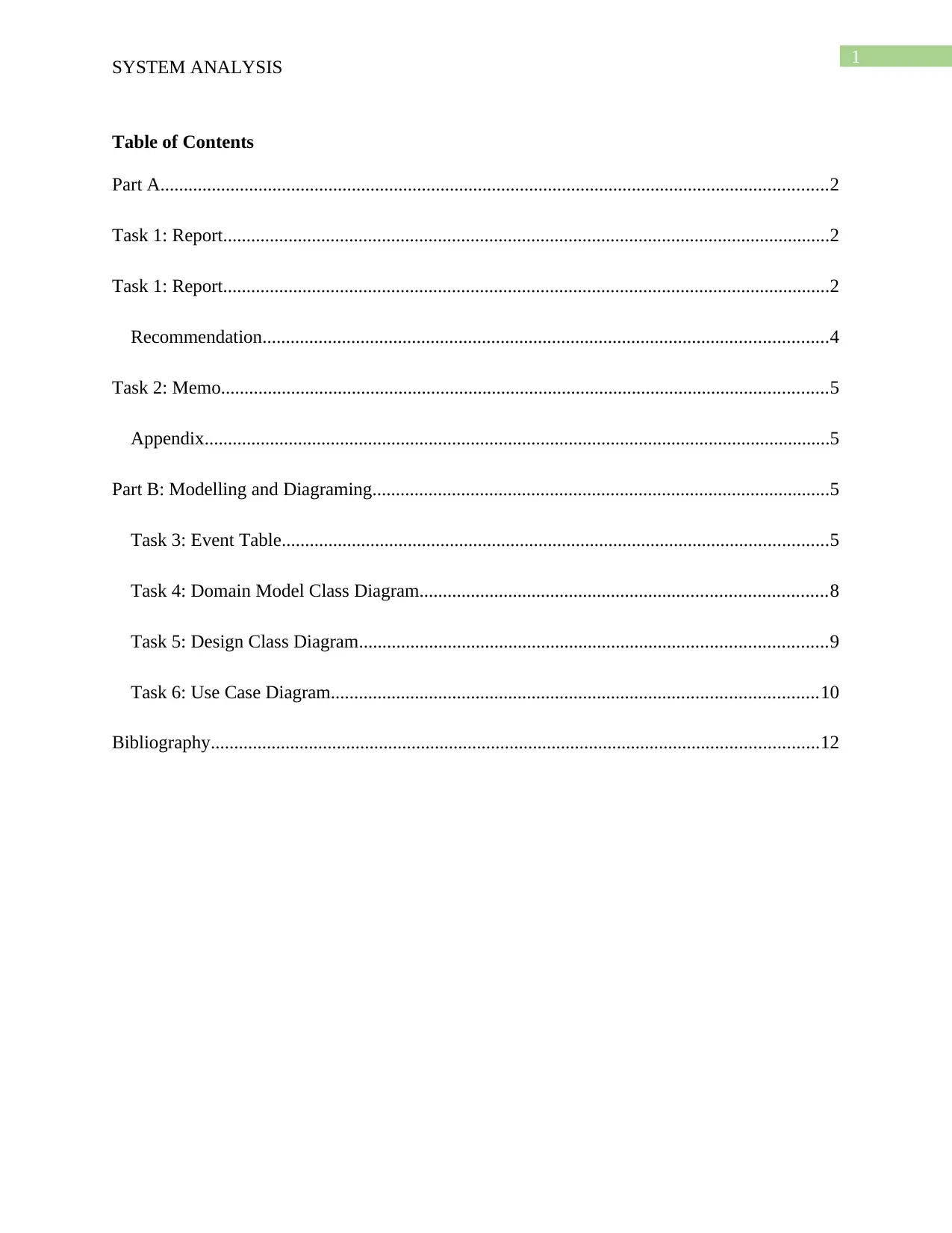
1
SYSTEM ANALYSIS
Table of Contents
Part A...............................................................................................................................................2
Task 1: Report..................................................................................................................................2
Task 1: Report..................................................................................................................................2
Recommendation.........................................................................................................................4
Task 2: Memo..................................................................................................................................5
Appendix......................................................................................................................................5
Part B: Modelling and Diagraming..................................................................................................5
Task 3: Event Table.....................................................................................................................5
Task 4: Domain Model Class Diagram.......................................................................................8
Task 5: Design Class Diagram....................................................................................................9
Task 6: Use Case Diagram........................................................................................................10
Bibliography..................................................................................................................................12
SYSTEM ANALYSIS
Table of Contents
Part A...............................................................................................................................................2
Task 1: Report..................................................................................................................................2
Task 1: Report..................................................................................................................................2
Recommendation.........................................................................................................................4
Task 2: Memo..................................................................................................................................5
Appendix......................................................................................................................................5
Part B: Modelling and Diagraming..................................................................................................5
Task 3: Event Table.....................................................................................................................5
Task 4: Domain Model Class Diagram.......................................................................................8
Task 5: Design Class Diagram....................................................................................................9
Task 6: Use Case Diagram........................................................................................................10
Bibliography..................................................................................................................................12
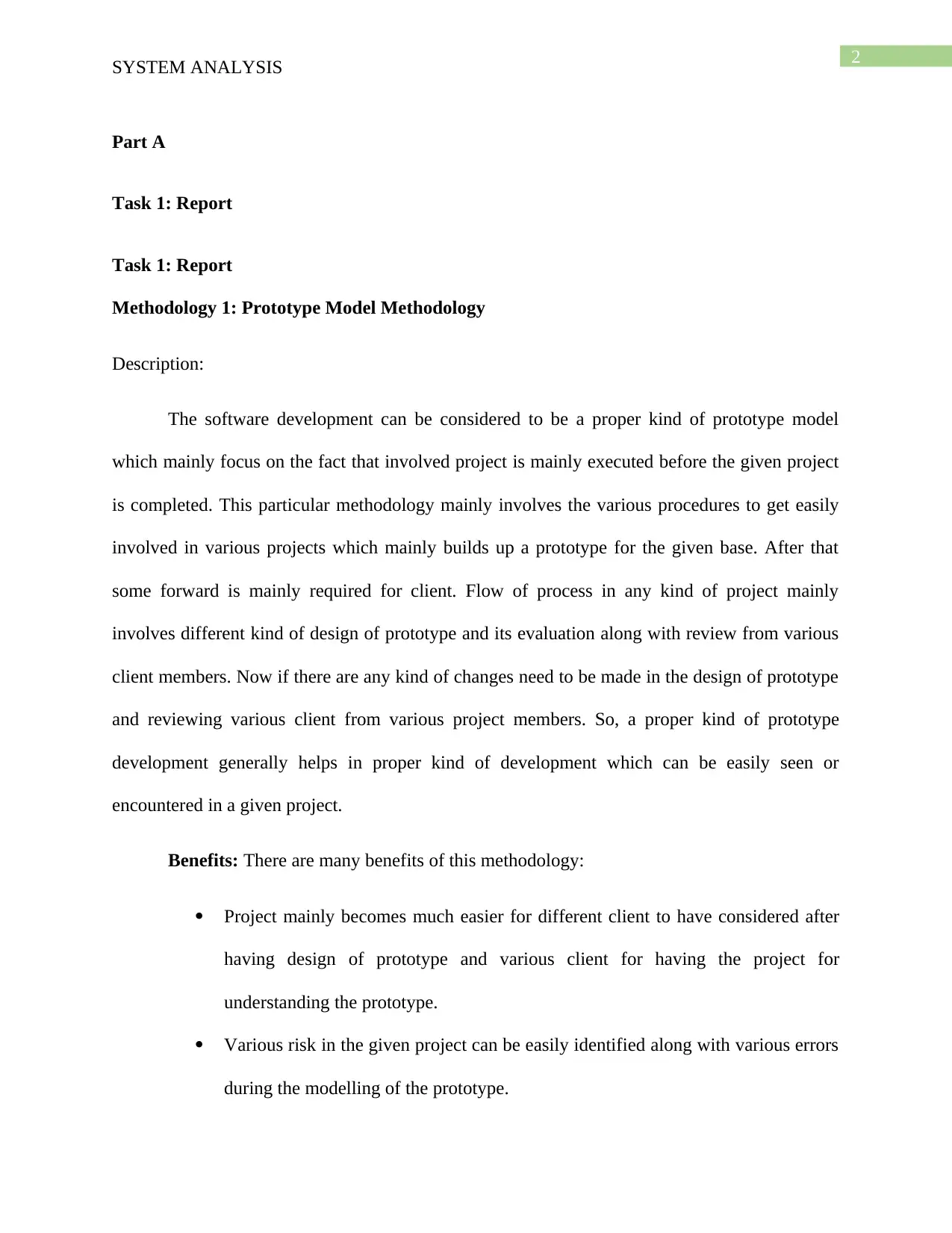
2
SYSTEM ANALYSIS
Part A
Task 1: Report
Task 1: Report
Methodology 1: Prototype Model Methodology
Description:
The software development can be considered to be a proper kind of prototype model
which mainly focus on the fact that involved project is mainly executed before the given project
is completed. This particular methodology mainly involves the various procedures to get easily
involved in various projects which mainly builds up a prototype for the given base. After that
some forward is mainly required for client. Flow of process in any kind of project mainly
involves different kind of design of prototype and its evaluation along with review from various
client members. Now if there are any kind of changes need to be made in the design of prototype
and reviewing various client from various project members. So, a proper kind of prototype
development generally helps in proper kind of development which can be easily seen or
encountered in a given project.
Benefits: There are many benefits of this methodology:
Project mainly becomes much easier for different client to have considered after
having design of prototype and various client for having the project for
understanding the prototype.
Various risk in the given project can be easily identified along with various errors
during the modelling of the prototype.
SYSTEM ANALYSIS
Part A
Task 1: Report
Task 1: Report
Methodology 1: Prototype Model Methodology
Description:
The software development can be considered to be a proper kind of prototype model
which mainly focus on the fact that involved project is mainly executed before the given project
is completed. This particular methodology mainly involves the various procedures to get easily
involved in various projects which mainly builds up a prototype for the given base. After that
some forward is mainly required for client. Flow of process in any kind of project mainly
involves different kind of design of prototype and its evaluation along with review from various
client members. Now if there are any kind of changes need to be made in the design of prototype
and reviewing various client from various project members. So, a proper kind of prototype
development generally helps in proper kind of development which can be easily seen or
encountered in a given project.
Benefits: There are many benefits of this methodology:
Project mainly becomes much easier for different client to have considered after
having design of prototype and various client for having the project for
understanding the prototype.
Various risk in the given project can be easily identified along with various errors
during the modelling of the prototype.
⊘ This is a preview!⊘
Do you want full access?
Subscribe today to unlock all pages.

Trusted by 1+ million students worldwide
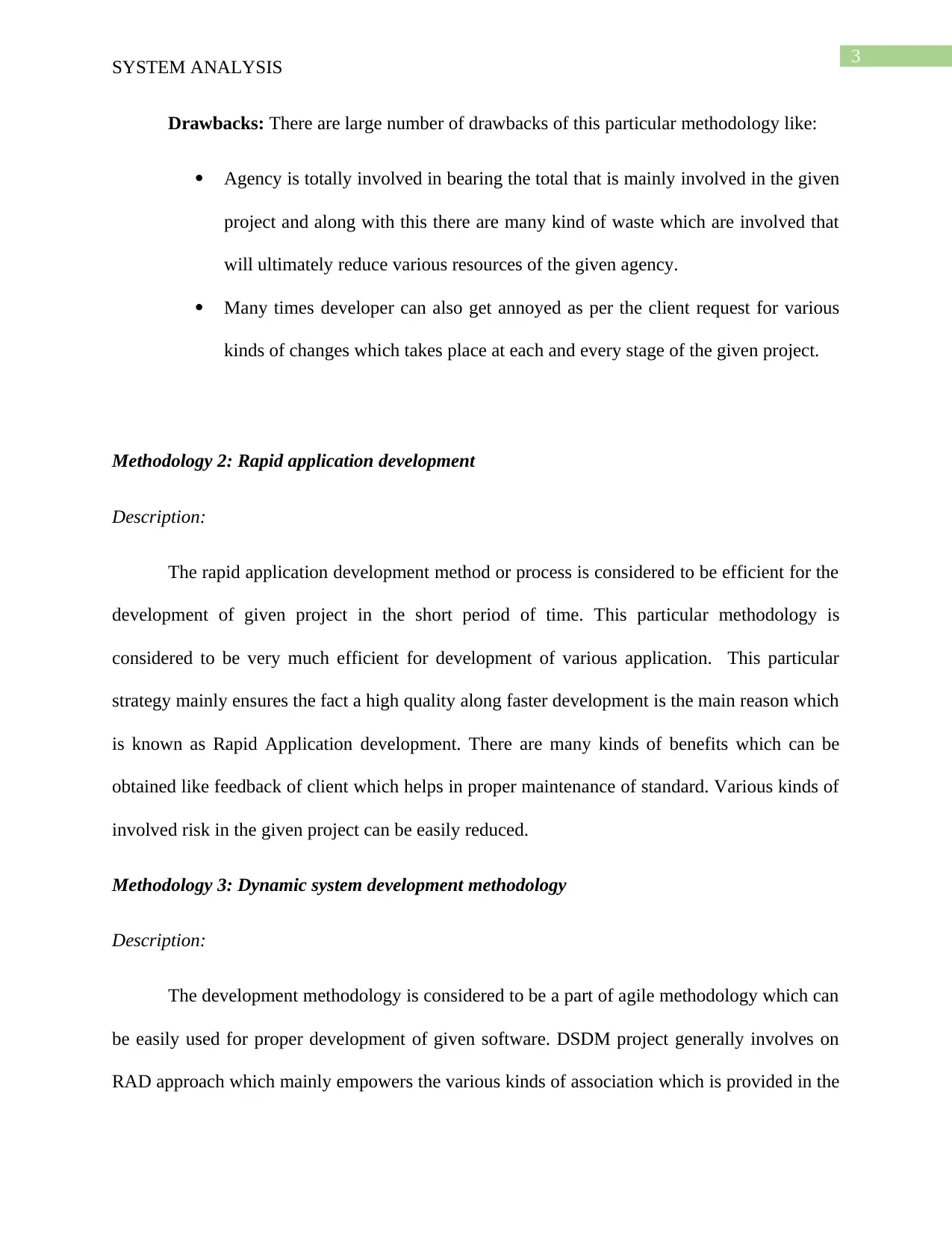
3
SYSTEM ANALYSIS
Drawbacks: There are large number of drawbacks of this particular methodology like:
Agency is totally involved in bearing the total that is mainly involved in the given
project and along with this there are many kind of waste which are involved that
will ultimately reduce various resources of the given agency.
Many times developer can also get annoyed as per the client request for various
kinds of changes which takes place at each and every stage of the given project.
Methodology 2: Rapid application development
Description:
The rapid application development method or process is considered to be efficient for the
development of given project in the short period of time. This particular methodology is
considered to be very much efficient for development of various application. This particular
strategy mainly ensures the fact a high quality along faster development is the main reason which
is known as Rapid Application development. There are many kinds of benefits which can be
obtained like feedback of client which helps in proper maintenance of standard. Various kinds of
involved risk in the given project can be easily reduced.
Methodology 3: Dynamic system development methodology
Description:
The development methodology is considered to be a part of agile methodology which can
be easily used for proper development of given software. DSDM project generally involves on
RAD approach which mainly empowers the various kinds of association which is provided in the
SYSTEM ANALYSIS
Drawbacks: There are large number of drawbacks of this particular methodology like:
Agency is totally involved in bearing the total that is mainly involved in the given
project and along with this there are many kind of waste which are involved that
will ultimately reduce various resources of the given agency.
Many times developer can also get annoyed as per the client request for various
kinds of changes which takes place at each and every stage of the given project.
Methodology 2: Rapid application development
Description:
The rapid application development method or process is considered to be efficient for the
development of given project in the short period of time. This particular methodology is
considered to be very much efficient for development of various application. This particular
strategy mainly ensures the fact a high quality along faster development is the main reason which
is known as Rapid Application development. There are many kinds of benefits which can be
obtained like feedback of client which helps in proper maintenance of standard. Various kinds of
involved risk in the given project can be easily reduced.
Methodology 3: Dynamic system development methodology
Description:
The development methodology is considered to be a part of agile methodology which can
be easily used for proper development of given software. DSDM project generally involves on
RAD approach which mainly empowers the various kinds of association which is provided in the
Paraphrase This Document
Need a fresh take? Get an instant paraphrase of this document with our AI Paraphraser
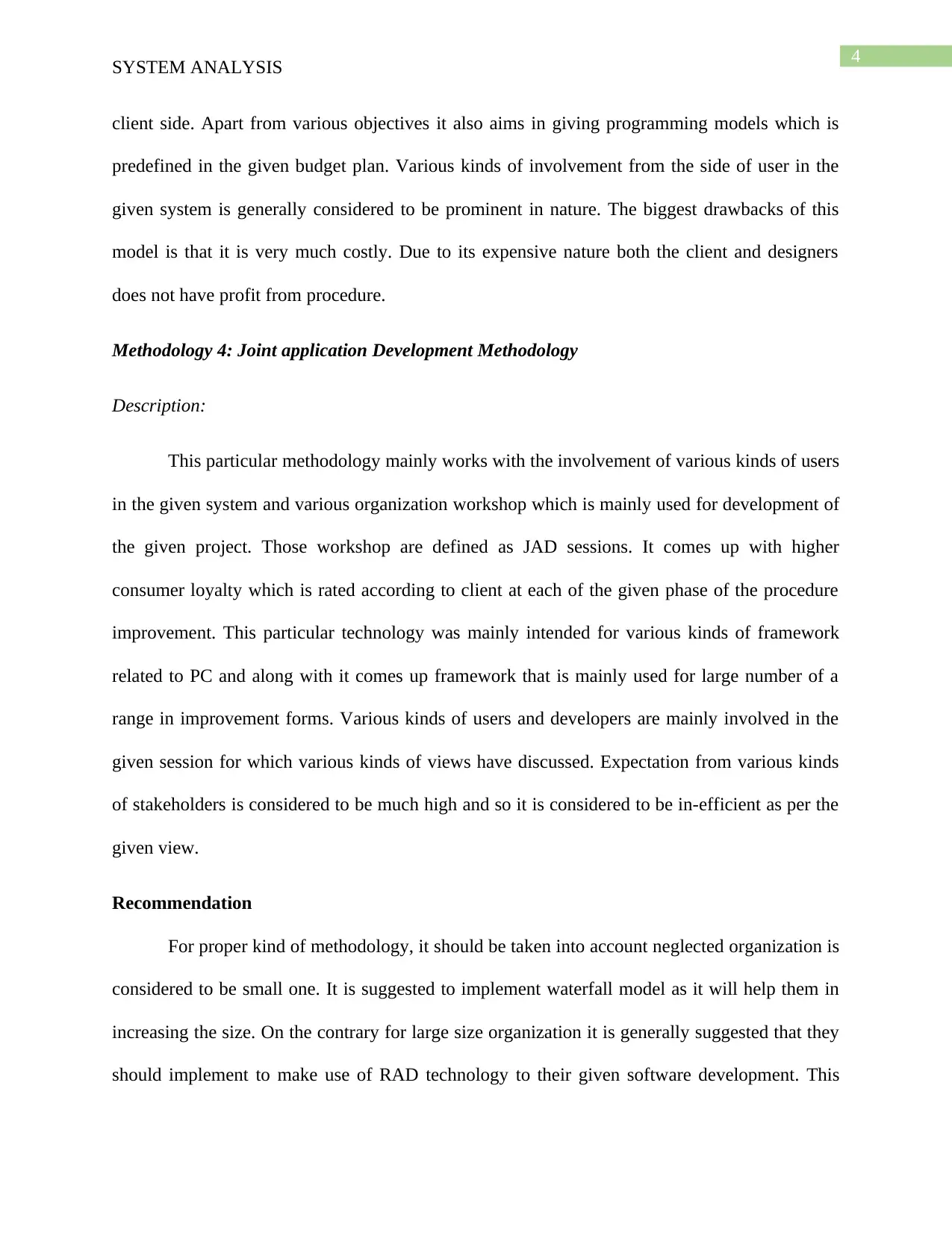
4
SYSTEM ANALYSIS
client side. Apart from various objectives it also aims in giving programming models which is
predefined in the given budget plan. Various kinds of involvement from the side of user in the
given system is generally considered to be prominent in nature. The biggest drawbacks of this
model is that it is very much costly. Due to its expensive nature both the client and designers
does not have profit from procedure.
Methodology 4: Joint application Development Methodology
Description:
This particular methodology mainly works with the involvement of various kinds of users
in the given system and various organization workshop which is mainly used for development of
the given project. Those workshop are defined as JAD sessions. It comes up with higher
consumer loyalty which is rated according to client at each of the given phase of the procedure
improvement. This particular technology was mainly intended for various kinds of framework
related to PC and along with it comes up framework that is mainly used for large number of a
range in improvement forms. Various kinds of users and developers are mainly involved in the
given session for which various kinds of views have discussed. Expectation from various kinds
of stakeholders is considered to be much high and so it is considered to be in-efficient as per the
given view.
Recommendation
For proper kind of methodology, it should be taken into account neglected organization is
considered to be small one. It is suggested to implement waterfall model as it will help them in
increasing the size. On the contrary for large size organization it is generally suggested that they
should implement to make use of RAD technology to their given software development. This
SYSTEM ANALYSIS
client side. Apart from various objectives it also aims in giving programming models which is
predefined in the given budget plan. Various kinds of involvement from the side of user in the
given system is generally considered to be prominent in nature. The biggest drawbacks of this
model is that it is very much costly. Due to its expensive nature both the client and designers
does not have profit from procedure.
Methodology 4: Joint application Development Methodology
Description:
This particular methodology mainly works with the involvement of various kinds of users
in the given system and various organization workshop which is mainly used for development of
the given project. Those workshop are defined as JAD sessions. It comes up with higher
consumer loyalty which is rated according to client at each of the given phase of the procedure
improvement. This particular technology was mainly intended for various kinds of framework
related to PC and along with it comes up framework that is mainly used for large number of a
range in improvement forms. Various kinds of users and developers are mainly involved in the
given session for which various kinds of views have discussed. Expectation from various kinds
of stakeholders is considered to be much high and so it is considered to be in-efficient as per the
given view.
Recommendation
For proper kind of methodology, it should be taken into account neglected organization is
considered to be small one. It is suggested to implement waterfall model as it will help them in
increasing the size. On the contrary for large size organization it is generally suggested that they
should implement to make use of RAD technology to their given software development. This
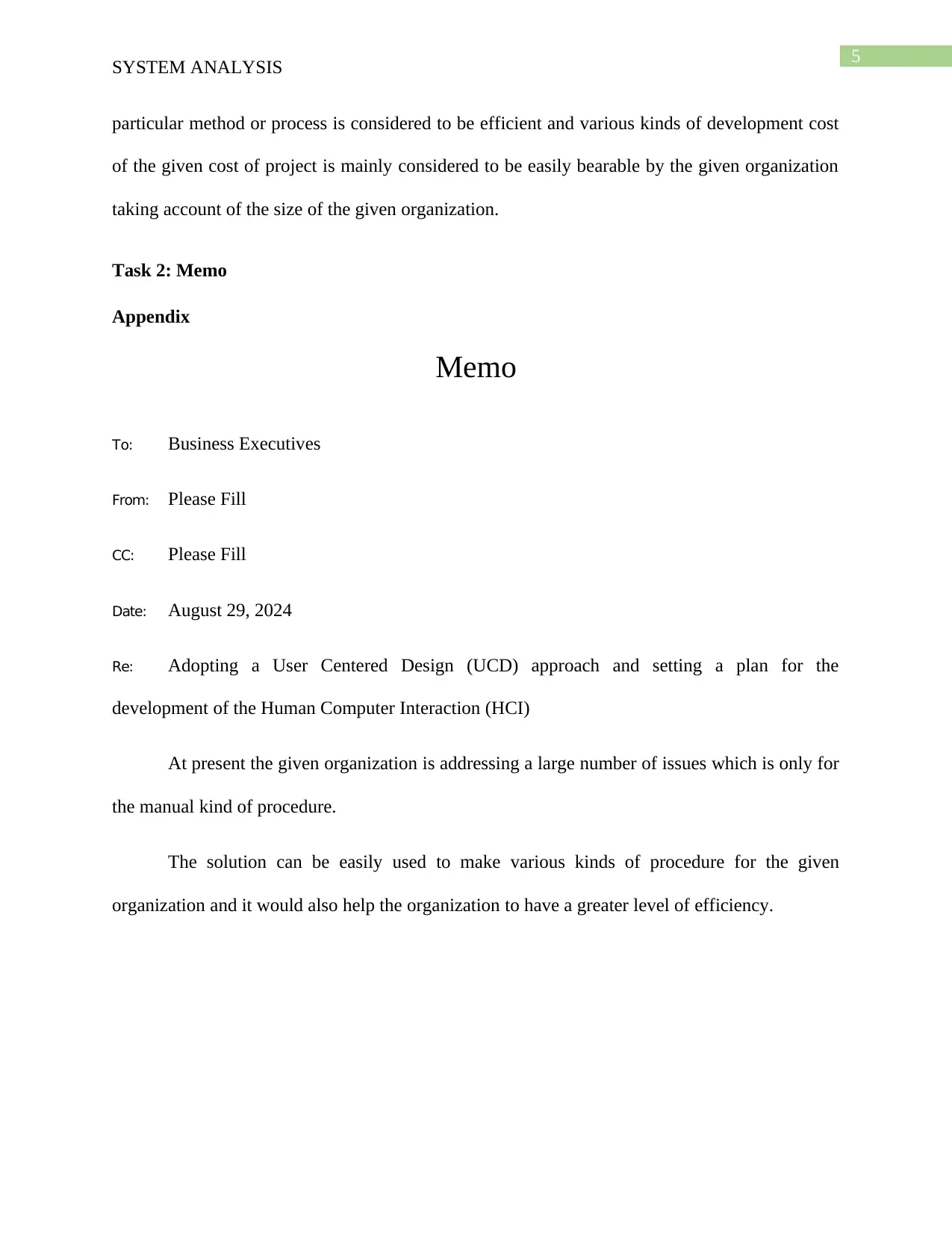
5
SYSTEM ANALYSIS
particular method or process is considered to be efficient and various kinds of development cost
of the given cost of project is mainly considered to be easily bearable by the given organization
taking account of the size of the given organization.
Task 2: Memo
Appendix
Memo
To: Business Executives
From: Please Fill
CC: Please Fill
Date: August 29, 2024
Re: Adopting a User Centered Design (UCD) approach and setting a plan for the
development of the Human Computer Interaction (HCI)
At present the given organization is addressing a large number of issues which is only for
the manual kind of procedure.
The solution can be easily used to make various kinds of procedure for the given
organization and it would also help the organization to have a greater level of efficiency.
SYSTEM ANALYSIS
particular method or process is considered to be efficient and various kinds of development cost
of the given cost of project is mainly considered to be easily bearable by the given organization
taking account of the size of the given organization.
Task 2: Memo
Appendix
Memo
To: Business Executives
From: Please Fill
CC: Please Fill
Date: August 29, 2024
Re: Adopting a User Centered Design (UCD) approach and setting a plan for the
development of the Human Computer Interaction (HCI)
At present the given organization is addressing a large number of issues which is only for
the manual kind of procedure.
The solution can be easily used to make various kinds of procedure for the given
organization and it would also help the organization to have a greater level of efficiency.
⊘ This is a preview!⊘
Do you want full access?
Subscribe today to unlock all pages.

Trusted by 1+ million students worldwide
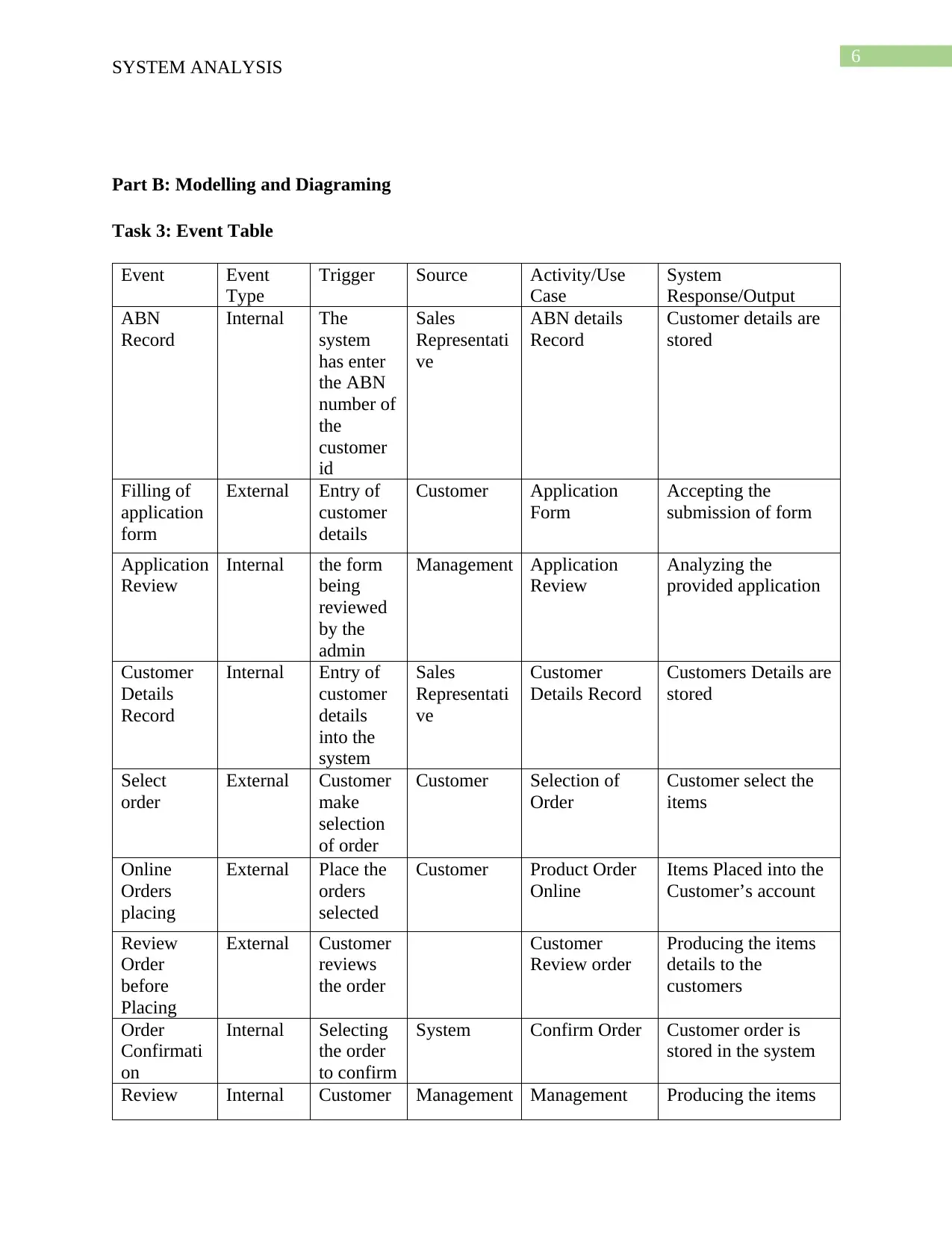
6
SYSTEM ANALYSIS
Part B: Modelling and Diagraming
Task 3: Event Table
Event Event
Type
Trigger Source Activity/Use
Case
System
Response/Output
ABN
Record
Internal The
system
has enter
the ABN
number of
the
customer
id
Sales
Representati
ve
ABN details
Record
Customer details are
stored
Filling of
application
form
External Entry of
customer
details
Customer Application
Form
Accepting the
submission of form
Application
Review
Internal the form
being
reviewed
by the
admin
Management Application
Review
Analyzing the
provided application
Customer
Details
Record
Internal Entry of
customer
details
into the
system
Sales
Representati
ve
Customer
Details Record
Customers Details are
stored
Select
order
External Customer
make
selection
of order
Customer Selection of
Order
Customer select the
items
Online
Orders
placing
External Place the
orders
selected
Customer Product Order
Online
Items Placed into the
Customer’s account
Review
Order
before
Placing
External Customer
reviews
the order
Customer
Review order
Producing the items
details to the
customers
Order
Confirmati
on
Internal Selecting
the order
to confirm
System Confirm Order Customer order is
stored in the system
Review Internal Customer Management Management Producing the items
SYSTEM ANALYSIS
Part B: Modelling and Diagraming
Task 3: Event Table
Event Event
Type
Trigger Source Activity/Use
Case
System
Response/Output
ABN
Record
Internal The
system
has enter
the ABN
number of
the
customer
id
Sales
Representati
ve
ABN details
Record
Customer details are
stored
Filling of
application
form
External Entry of
customer
details
Customer Application
Form
Accepting the
submission of form
Application
Review
Internal the form
being
reviewed
by the
admin
Management Application
Review
Analyzing the
provided application
Customer
Details
Record
Internal Entry of
customer
details
into the
system
Sales
Representati
ve
Customer
Details Record
Customers Details are
stored
Select
order
External Customer
make
selection
of order
Customer Selection of
Order
Customer select the
items
Online
Orders
placing
External Place the
orders
selected
Customer Product Order
Online
Items Placed into the
Customer’s account
Review
Order
before
Placing
External Customer
reviews
the order
Customer
Review order
Producing the items
details to the
customers
Order
Confirmati
on
Internal Selecting
the order
to confirm
System Confirm Order Customer order is
stored in the system
Review Internal Customer Management Management Producing the items
Paraphrase This Document
Need a fresh take? Get an instant paraphrase of this document with our AI Paraphraser
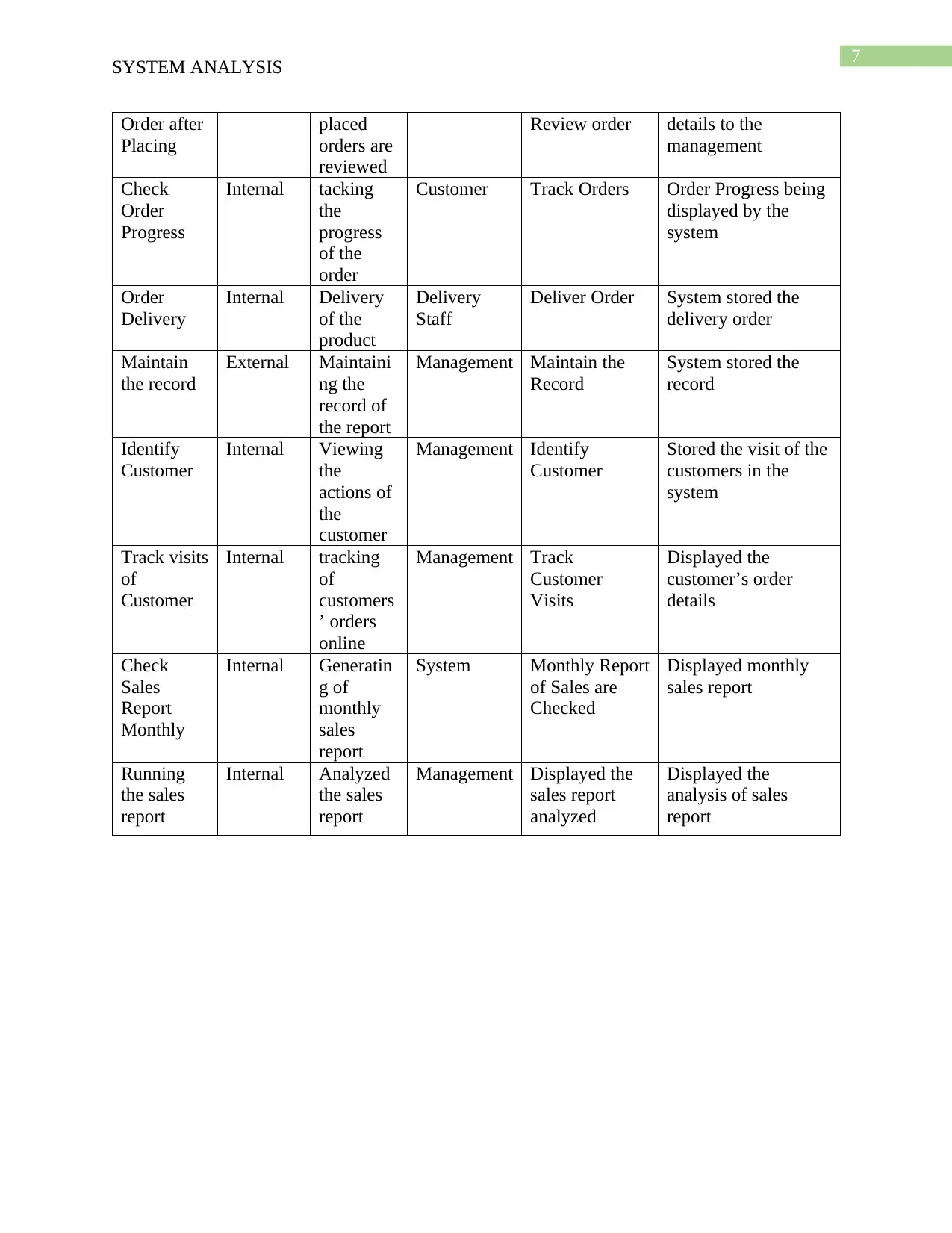
7
SYSTEM ANALYSIS
Order after
Placing
placed
orders are
reviewed
Review order details to the
management
Check
Order
Progress
Internal tacking
the
progress
of the
order
Customer Track Orders Order Progress being
displayed by the
system
Order
Delivery
Internal Delivery
of the
product
Delivery
Staff
Deliver Order System stored the
delivery order
Maintain
the record
External Maintaini
ng the
record of
the report
Management Maintain the
Record
System stored the
record
Identify
Customer
Internal Viewing
the
actions of
the
customer
Management Identify
Customer
Stored the visit of the
customers in the
system
Track visits
of
Customer
Internal tracking
of
customers
’ orders
online
Management Track
Customer
Visits
Displayed the
customer’s order
details
Check
Sales
Report
Monthly
Internal Generatin
g of
monthly
sales
report
System Monthly Report
of Sales are
Checked
Displayed monthly
sales report
Running
the sales
report
Internal Analyzed
the sales
report
Management Displayed the
sales report
analyzed
Displayed the
analysis of sales
report
SYSTEM ANALYSIS
Order after
Placing
placed
orders are
reviewed
Review order details to the
management
Check
Order
Progress
Internal tacking
the
progress
of the
order
Customer Track Orders Order Progress being
displayed by the
system
Order
Delivery
Internal Delivery
of the
product
Delivery
Staff
Deliver Order System stored the
delivery order
Maintain
the record
External Maintaini
ng the
record of
the report
Management Maintain the
Record
System stored the
record
Identify
Customer
Internal Viewing
the
actions of
the
customer
Management Identify
Customer
Stored the visit of the
customers in the
system
Track visits
of
Customer
Internal tracking
of
customers
’ orders
online
Management Track
Customer
Visits
Displayed the
customer’s order
details
Check
Sales
Report
Monthly
Internal Generatin
g of
monthly
sales
report
System Monthly Report
of Sales are
Checked
Displayed monthly
sales report
Running
the sales
report
Internal Analyzed
the sales
report
Management Displayed the
sales report
analyzed
Displayed the
analysis of sales
report
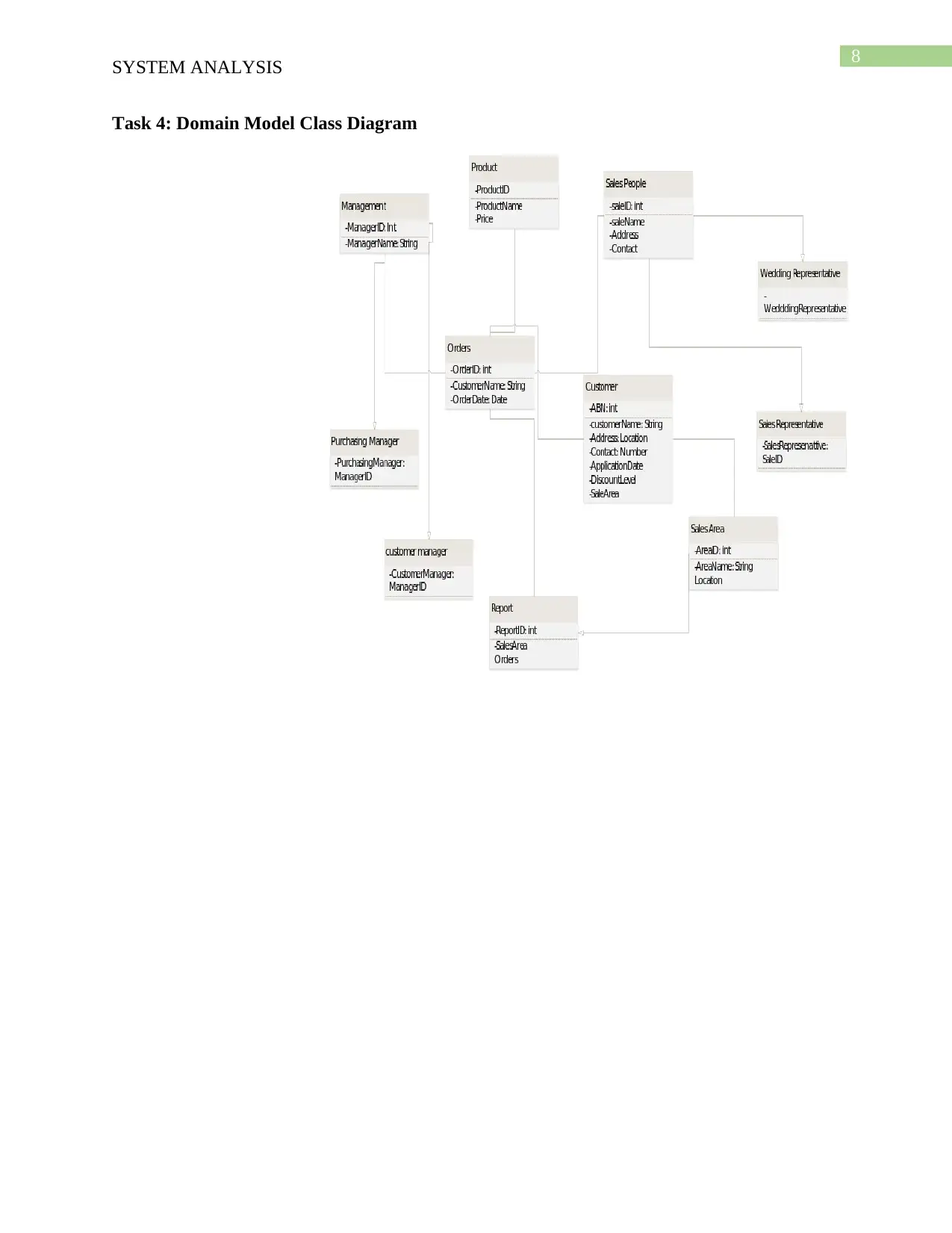
8
SYSTEM ANALYSIS
Task 4: Domain Model Class Diagram
SYSTEM ANALYSIS
Task 4: Domain Model Class Diagram
⊘ This is a preview!⊘
Do you want full access?
Subscribe today to unlock all pages.

Trusted by 1+ million students worldwide
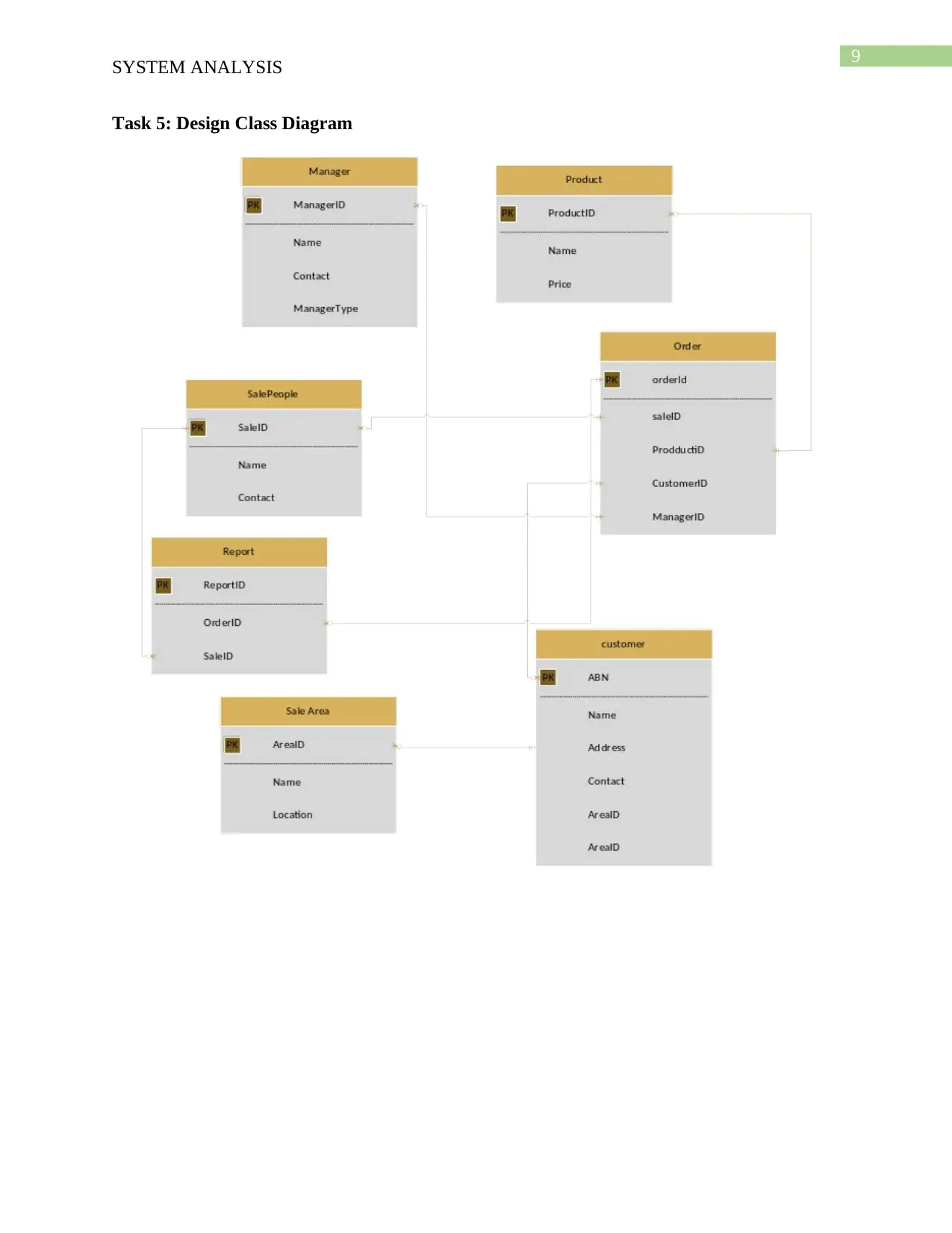
9
SYSTEM ANALYSIS
Task 5: Design Class Diagram
SYSTEM ANALYSIS
Task 5: Design Class Diagram
Paraphrase This Document
Need a fresh take? Get an instant paraphrase of this document with our AI Paraphraser
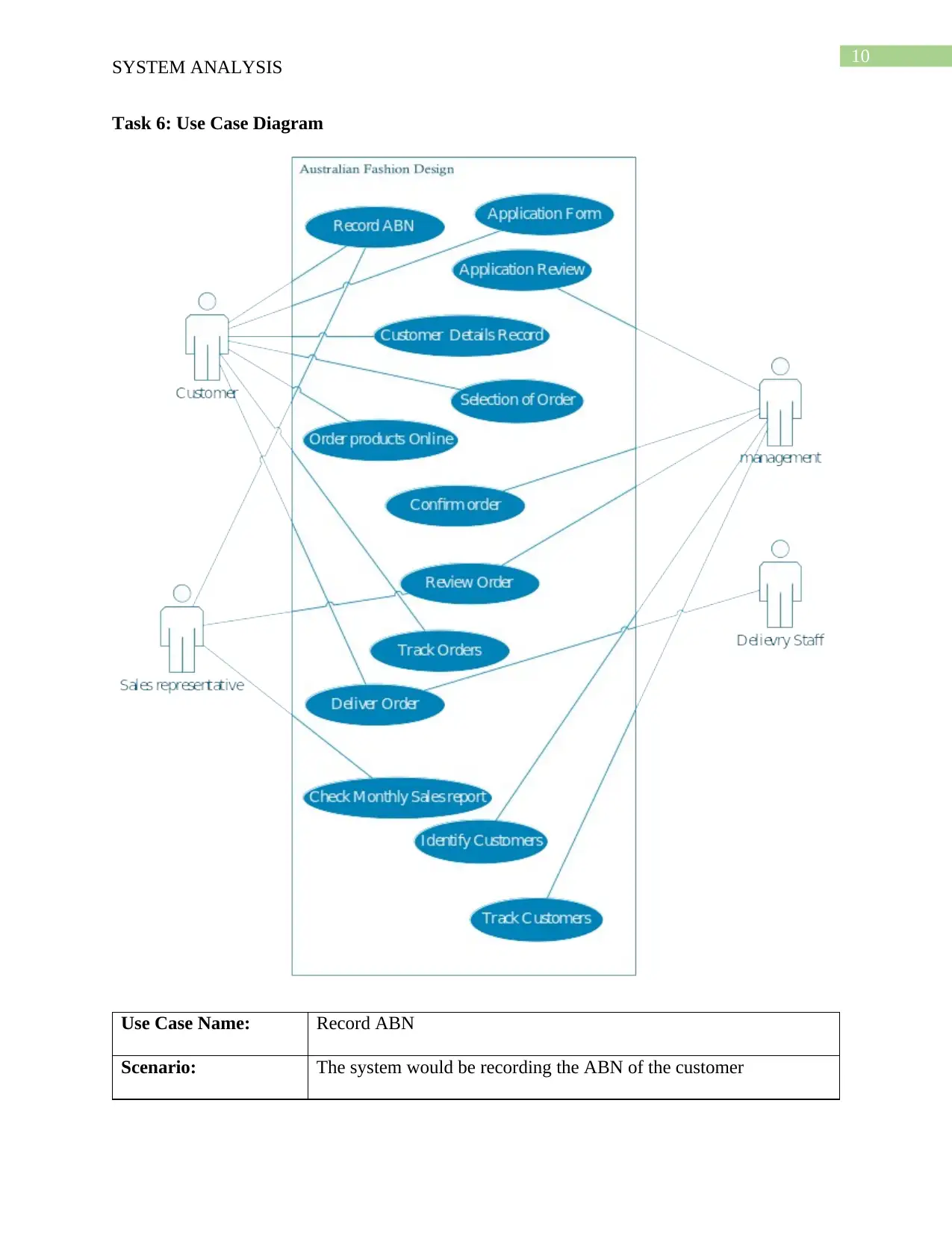
10
SYSTEM ANALYSIS
Task 6: Use Case Diagram
Use Case Name: Record ABN
Scenario: The system would be recording the ABN of the customer
SYSTEM ANALYSIS
Task 6: Use Case Diagram
Use Case Name: Record ABN
Scenario: The system would be recording the ABN of the customer
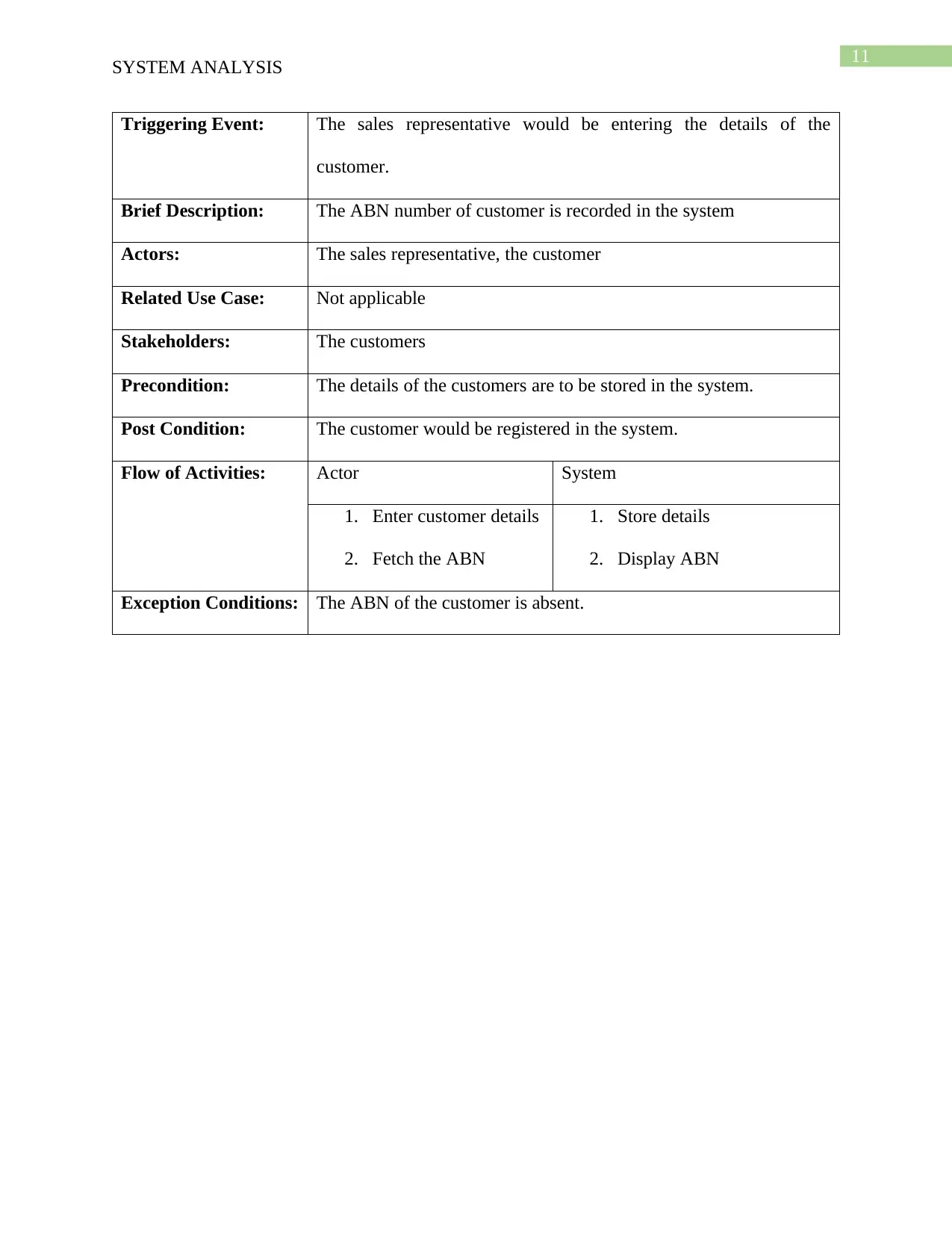
11
SYSTEM ANALYSIS
Triggering Event: The sales representative would be entering the details of the
customer.
Brief Description: The ABN number of customer is recorded in the system
Actors: The sales representative, the customer
Related Use Case: Not applicable
Stakeholders: The customers
Precondition: The details of the customers are to be stored in the system.
Post Condition: The customer would be registered in the system.
Flow of Activities: Actor System
1. Enter customer details
2. Fetch the ABN
1. Store details
2. Display ABN
Exception Conditions: The ABN of the customer is absent.
SYSTEM ANALYSIS
Triggering Event: The sales representative would be entering the details of the
customer.
Brief Description: The ABN number of customer is recorded in the system
Actors: The sales representative, the customer
Related Use Case: Not applicable
Stakeholders: The customers
Precondition: The details of the customers are to be stored in the system.
Post Condition: The customer would be registered in the system.
Flow of Activities: Actor System
1. Enter customer details
2. Fetch the ABN
1. Store details
2. Display ABN
Exception Conditions: The ABN of the customer is absent.
⊘ This is a preview!⊘
Do you want full access?
Subscribe today to unlock all pages.

Trusted by 1+ million students worldwide
1 out of 13
Related Documents
Your All-in-One AI-Powered Toolkit for Academic Success.
+13062052269
info@desklib.com
Available 24*7 on WhatsApp / Email
![[object Object]](/_next/static/media/star-bottom.7253800d.svg)
Unlock your academic potential
Copyright © 2020–2025 A2Z Services. All Rights Reserved. Developed and managed by ZUCOL.



